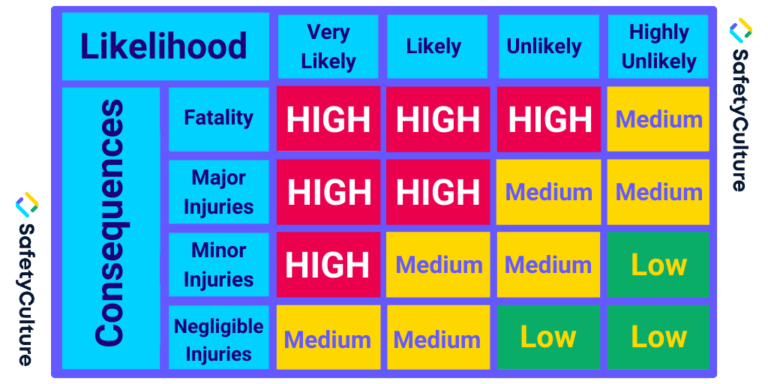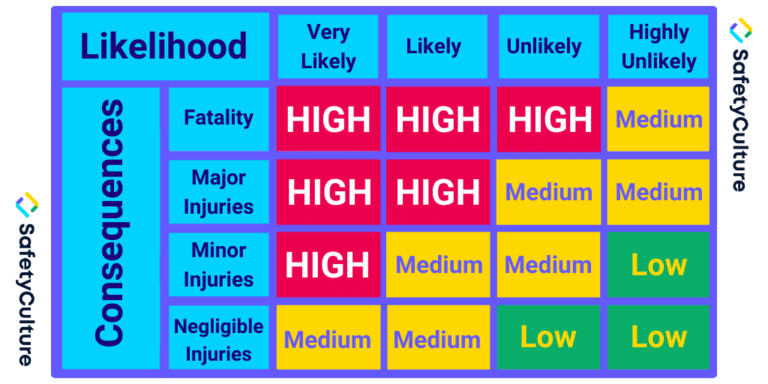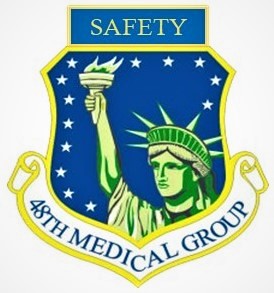Title Page
-
Site conducted
-
Location of Workplace
-
Prepared on
-
Prepared by
Initial Questions
-
Why is this workplace violence risk assessment needed? (Other than being legally required)
-
How could this workplace violence risk assessment help the business and its employees?
-
What is the intended result, effect, or output of this workplace violence risk assessment?
-
What's included in this workplace violence risk assessment?
-
What's not included in this workplace violence risk assessment?
-
Who will be involved in this workplace violence risk assessment and what level of responsibility or participation do they have?
-
When will this workplace violence risk assessment be performed?
-
Where (specific room, site, facility, building, or area) will this workplace violence risk assessment be performed?
Identify the hazards
-
Gather information about the hazards in your workplace.
-
Ask your employees and safety representatives about their experiences and what they think.
-
Look back at your injury and illness health records.
-
List the workplace violence hazards you have observed and/or experienced as well as those you suspect are happening in the workplace:
Common Workplace Violence Hazards
-
For areas that involve counseling/mental wellness:
-
Disagreements between staff and/or patients
-
Create action -Study hazard- by selecting the "Action" icon. Set a due date.
-
What risk would this hazard possibly lead to?
-
What is a possible consequence of this risk?
-
How likely is it for this possible consequence to actually occur?
-
Identify the risk level using this risk matrix:
-
What is the risk level?
-
High-level risks must be prioritized.
-
Patients being intoxicated
-
Create action -Study hazard- by selecting the "Action" icon. Set a due date.
-
What risk would this hazard possibly lead to?
-
What is a possible consequence of this risk?
-
How likely is it for this possible consequence to actually occur?
-
Identify the risk level using this risk matrix:
-
What is the risk level?
-
High-level risks must be prioritized.
-
Patients/Staff using illegal drugs
-
Create action -Study hazard- by selecting the "Action" icon. Set a due date.
-
What risk would this hazard possibly lead to?
-
What is a possible consequence of this risk?
-
How likely is it for this possible consequence to actually occur?
-
Identify the risk level using this risk matrix:
-
What is the risk level?
-
High-level risks must be prioritized.
-
For Clinical/Non-clinical/Ancillary Support:
-
Unpredictable behavior of patients/staff/customers
-
Create action -Study hazard- by selecting the "Action" icon. Set a due date.
-
What risk would this hazard possibly lead to?
-
What is a possible consequence of this risk?
-
How likely is it for this possible consequence to actually occur?
-
Identify the risk level using this risk matrix:
-
What is the risk level?
-
High-level risks must be prioritized.
-
Verbal abuse (usually more common than physical violence)
-
Create action -Study hazard- by selecting the "Action" icon. Set a due date.
-
What risk would this hazard possibly lead to?
-
What is a possible consequence of this risk?
-
How likely is it for this possible consequence to actually occur?
-
Identify the risk level using this risk matrix:
-
What is the risk level?
-
High-level risks must be prioritized.
Who might be harmed and how?
-
Work out whether and how violence, or the fear of violence, could affect staff in your workplace.
-
Identify which groups of people in your hospital could be harmed by physical assaults, threats, intimidation, or verbal abuse.
-
Talk to staff about the situations where they feel threatened, as well as situations that might pose a risk, EVEN IF they do not cause concern to staff at the moment.
Evaluate the risks and decide on precautions
-
Please specify if these risk factors are present or absent in the workplace:
-
Staff has face-to-face contact with patients/customers
-
What is a possible consequence of this risk?
-
How likely is it for this possible consequence to actually occur?
-
Identify the risk level using the risk matrix below:
-
What is the risk level?
-
High-level risks must be prioritized.
-
Workplace operates in the evening or late at night
-
What is a possible consequence of this risk?
-
How likely is it for this possible consequence to actually occur?
-
Identify the risk level using the risk matrix below:
-
What is the risk level?
-
High-level risks must be prioritized.
-
Staff deals with patient/customer complaints or disputes
-
What is a possible consequence of this risk?
-
How likely is it for this possible consequence to actually occur?
-
Identify the risk level using the risk matrix below:
-
What is the risk level?
-
High-level risks must be prioritized.
-
Workplace has lone workers or small numbers of staff
-
What is a possible consequence of this risk?
-
How likely is it for this possible consequence to actually occur?
-
Identify the risk level using the risk matrix below:
-
What is the risk level?
-
High-level risks must be prioritized.
-
Workplace stores high-value goods such as medications, equipment and supplies
-
What is a possible consequence of this risk?
-
How likely is it for this possible consequence to actually occur?
-
Identify the risk level using the risk matrix below:
-
What is the risk level?
-
High-level risks must be prioritized.
-
Staff is under extreme pressure due to exceptional workloads and/or staff shortages
-
What is a possible consequence of this risk?
-
How likely is it for this possible consequence to actually occur?
-
Identify the risk level using the risk matrix below:
-
What is the risk level?
-
High-level risks must be prioritized.
-
Staff regularly faces inadequate stocks, delays, and long wait times, leading to patient dissatisfaction and/or hostility to be directed at them
-
What is a possible consequence of this risk?
-
How likely is it for this possible consequence to actually occur?
-
Identify the risk level using the risk matrix below:
-
What is the risk level?
-
High-level risks must be prioritized.
-
Patients have a history of violence
-
What is a possible consequence of this risk?
-
How likely is it for this possible consequence to actually occur?
-
Identify the risk level using the risk matrix below:
-
What is the risk level?
-
High-level risks must be prioritized.
-
Patients are likely to be under the influence of drink or drugs
-
What is a possible consequence of this risk?
-
How likely is it for this possible consequence to actually occur?
-
Identify the risk level using the risk matrix below:
-
What is the risk level?
-
High-level risks must be prioritized.
-
Workplace has had a previous experience of assault, threats, or theft
-
What is a possible consequence of this risk?
-
How likely is it for this possible consequence to actually occur?
-
Identify the risk level using the risk matrix below:
-
What is the risk level?
-
High-level risks must be prioritized.
-
Workplace is isolated or does not have many patients/customers
-
What is a possible consequence of this risk?
-
How likely is it for this possible consequence to actually occur?
-
Identify the risk level using the risk matrix below:
-
What is the risk level?
-
High-level risks must be prioritized.
-
Workplace has easy access/escape routes that can be taken advantage of
-
What is a possible consequence of this risk?
-
How likely is it for this possible consequence to actually occur?
-
Identify the risk level using the risk matrix below:
-
What is the risk level?
-
High-level risks must be prioritized.
-
Workplace layout is poor (emergency egress is obstructed, etc.)
-
What is a possible consequence of this risk?
-
How likely is it for this possible consequence to actually occur?
-
Identify the risk level using the risk matrix below:
-
What is the risk level?
-
High-level risks must be prioritized.
-
Workplace lighting is poor (low visibility, etc.)
-
What is a possible consequence of this risk?
-
How likely is it for this possible consequence to actually occur?
-
Identify the risk level using the risk matrix below:
-
What is the risk level?
-
High-level risks must be prioritized.
-
Workplace does not have any obvious or highly visible security measures
-
What is a possible consequence of this risk?
-
How likely is it for this possible consequence to actually occur?
-
Identify the risk level using the risk matrix below:
-
What is the risk level?
-
High-level risks must be prioritized.
Record your findings and implement them
-
Consult staff about their opinions on the risk factors present in the workplace and their ideas for controlling workplace violence risks
-
Ask staff to share on-the-job experiences to help other employees recognize and respond to violence as safely as possible
-
Ask staff to participate in the evaluation of any control measures
-
Work out what you are already doing, whether your control measures are working properly and if there is anything else you need to do
-
Are new control measures needed?
Develop risk control measures
-
Ask staff to participate in developing and devising procedures to minimize risk
-
Can more than one measure be used?
-
Can a mix of both short and long-term measures that result in both 'quick wins' and longer-term effectiveness be used?
-
Describe the proposed control measure/s:
-
How will staff react to these measures (or measure)?
-
How can you or the employer demonstrate the value of such measure/s?
-
What are the potential negative aspects of the measure/s (such as dress codes, searches, strict return policies)?
-
How will these interventions (or intervention) cost in comparison to their/its effectiveness?
-
Are/Is the measure/s realistic?
-
Has everyone (staff, employer, management) agreed to these measures (or measure)?
-
How will you effectively and consistently inform, instruct and train staff in these measures (or measure)?
-
Have specific timescales or deadlines been set for these measures (or measure)?
-
What are the actions involved in these measures (or measure)?
-
How will these actions be implemented? Include details on who will do each action and by when.
-
Appoint a responsible person to ensure that actions are carried out.
-
How will the implementation of such actions be communicated to the staff?
Review your risk assessment and update if necessary
-
You should review your workplace violence risk assessment regularly in case the hazard, risk factors or the control measures needed have changed.
-
Create action -Review workplace violence risk assessment- by selecting the "Action" icon.
-
Select "Update action details" Then, change "Due" date to approx. 1 year from today.
-
-
Review workplace violence risk assessments at least annually.
-
Review workplace violence risk assessments at least annually.
-
Name and Signature of Employer
-
Name and Signature of Person Appointed by Employer (if applicable)












